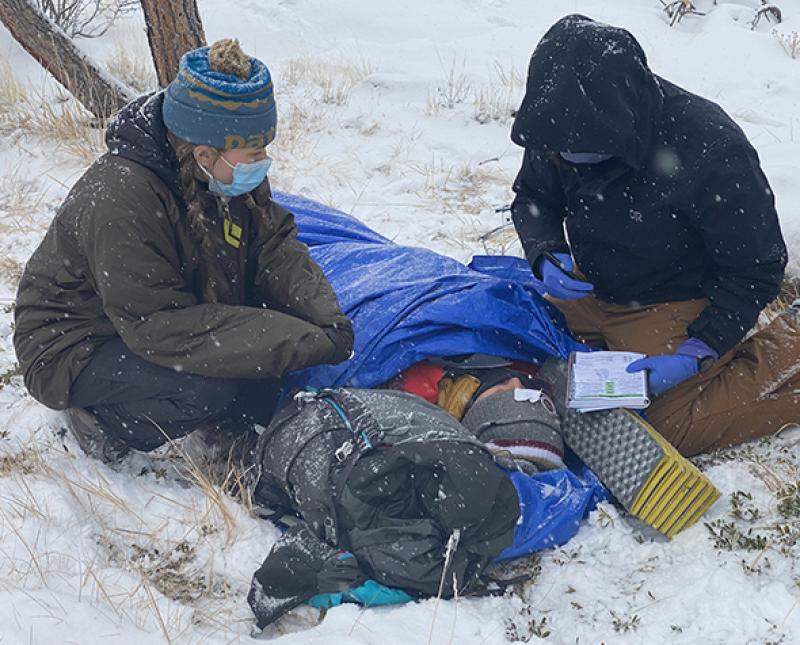Interterm Wilderness First Responders Course Hosted at Kennedy Mountain Campus

As darkness descends on the Kennedy Mountain Campus, a man lies in the brush with a bone protruding from his arm, flashes of red glimpsed in the semi-blackness.
Don’t worry, though. The man is Matt Jensen, director of Outdoor Experience and Programs at KMC and one of the instructors for a wilderness first responder interterm course hosted on the University of Denver’s slice of northern Colorado wilderness. Both the bone and blood are fake. The goal, however, is to create an elevated response in the students who could potentially treat such injuries.
In Jensen’s case, it was a simulated crash of a utility task vehicle resulting in a victim with a compound fracture. While students focused on the gruesome fake injury, Jensen was portraying a diabetic, something that further complicated the simulated treatment and helped open their eyes to the endless wrinkles that can happen emergency medical care.
The next day, with several inches of snow on the ground, the class simulated a ski accident with a broken femur. Student actors hooted and hollered as the class members asked them questions, rolled them onto insulated pads and wrapped them in waterproof tarps.
Nathan Page, the assistant director of Outdoor Experience and Programs, as well as one of the class instructors, says the mountain campus offers a unique environment for training.
“The beauty of this campus is that you’re out in the elements,” Page says. “It snows a lot in Denver, but we have all of the snow, all of the wind and all of the factors that could possibly affect their ability to give good patient care. They have to practice really good self-care to make sure they can sustainably provide medical aid in this type of environment.”
The course was sponsored by Nancy Lorenzon, a professor of biological sciences at the College of Natural Sciences & Mathematics who is also the faculty director for emergency medical services program.
A year ago, she took part in a nine-day wilderness first responder course to grow her own knowledge base and says the experience empowered her on her own outdoor adventures hiking and backpacking. Whether a student is looking for a career in EMS or just wants to be prepared, wilderness first aid a specialized type of care that can save lives.
“Education in wilderness medicine can serve two important goals: providing hands-on, experiential learning opportunities and helping students and the community be safer in our Colorado wilderness,” Lorenzon says. “Learning how to provide care in austere and challenging conditions is valuable, not only to serve in the mountains and backcountry but also to learn how to provide care with limited resources in rural areas.”
While the snowy KMC backdrop provided excellent conditions for field work, it also housed a series of classroom lectures where students—most still partly clad in winter clothes—learned various courses of treatment and discussed methodology as a group.
The classroom setting was also used as a space to help correct mistakes and home in on areas of focus for upcoming scenarios before students were thrust back into the elements. Page says this part of the course is key because the outdoor learning is what sets this course apart.
“It’s so different from all these other first aid classes they may have taken where they’re in this sterile, indoor environment or an [emergency room], even,” Page says. “Having them react in different environments, getting those real stress reactions in those environments with moulage and fake blood, and then having them use a systematic approach to figuring out what’s the most important to the most trivial, when they encounter an accident for real they can click into that framework that they’ve practiced so heavily.”
Most of the students taking the course were either loosely interested in wilderness first aid or working toward summer jobs as raft guides, camp counselors or other positions in the outdoor industry. DU student D.J. Darquea-Juris works for Stadium Medical as an EMT and says he’s mulled over working for 911 response or ski patrol, and the course offered flexibility for future medical careers.
“It covers basically anything backcountry that could happen in Colorado,” he says. “Anything like ski patrol, search and rescue, and that part was intriguing. Most of all, though, it was a refresher for lost skills that you don’t really use being an EMT in the city.”
Although most of the current batch of students weren’t working towards a career in medical care, Page added that the course can be an inroad to such professions.
“It’s a really cool and fairly accessible way to engage with the medical field more broadly,” Page says. “Those who are pre-med or have interest, they can take a course like that and see if it really excites them. We’ve seen lots of stories of students who have taken a course like this and gone on to be a wilderness EMT or nursing or any of the other professions down the line. It’s a cool way to test the waters without a ton of equipment or a huge investment.”


